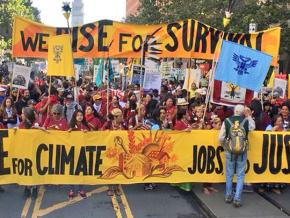The Bay Area marches against climate change
, a member of United Educators of San Francisco, reports on the tens of thousands of people who turned out in California as part of a global day of climate action.
NEARLY 40,000 protesters marched through the streets of San Francisco on September 8 to demand that corporations and governments around the world take action to address climate change.
The San Francisco action was timed to coincide with a global day of action that brought together hundreds of thousands of protesters at 850 events across 90 countries and seven continents. Organizers chose San Francisco for the event because of the upcoming Global Climate Action Summit taking place there on September 12-14.
Indigenous peoples from all over the state and across the world led the San Francisco march. One sign from a group that represented Pacific Islanders read, “The Pacific Ocean is our homeland! We are not drowning, we are fighting!” This continued a recent theme of putting those frontline communities at the front of these marches.
The seemingly endless stream of organized contingents that filled the streets were striking for their diversity. There were people associated with Coleman Advocates, which focuses on building more effective, equitable and supportive public schools in San Francisco. And then there were 1,000 Grandmothers, who are elder women activists working to address the climate crisis.

There was also a large showing by labor unions, including the International Longshore and Warehouse Union, International Federation of Professional and Technical Engineers, United Educators of San Francisco and many others, forming a large labor contingent.
“It is important for teachers to mobilize because we want to have a future on this planet, for our students and for everyone,” explained Berkeley teacher Kathleen Gadway.
The scale of the climate crisis — with California facing its worst fire season ever — is one major reason for the gathering momentum behind the movement. Another is the effort by organizers to advance inclusive demands with the ability to unite a broad cross-section of society. The event’s organizing slogan was “Rise for Climate, Jobs and Justice.”
The day of action was also animated by the Trump administration’s withdrawal of the U.S. from the Paris climate agreement.
“The protests are important because they show the government that we care and that they can’t do whatever they want,” said Cinthya Cano of Sacramento, about why she was marching. “It shows our power, and that we’re united.”
THE MARCH was also an opportunity to point out the limitations of this week’s Global Climate Action Summit.
Convened by California Gov. Jerry Brown to implement the terms of the Paris agreement despite the federal government’s withdrawal, the conference includes many notable meetings and guest speakers like former Vice President Al Gore.
But insofar as the conference is mainly concerned with making capitalism greener, its ability to implement the radical solutions necessary to address the rapidly spiraling climate crisis will be hampered.
The conference, for example, is highlighting “transformative climate investment” as a step towards fending off climate change. But Brown’s own record shows how such investments are constantly offset by other profit-seeking ventures. Brown’s administration has issued more than 20,000 new approvals for mining oil and gas, as well as 238 offshore oil-drilling operations.
These drilling permits — combined with the campaign contributions Brown has received — have many seeing brown, not green. Activists, however, are not letting the summit or Brown go unchallenged. Coordinated direct action will continue the work of the march at the Global Climate Action Summit.


